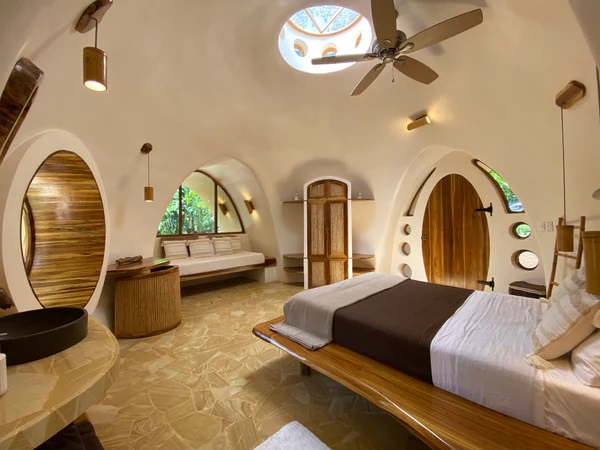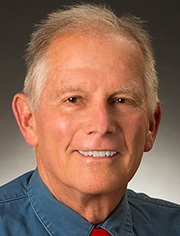Developer proposes dome homes for Eastpoint
They look a bit like concrete igloos, and one developer thinks they might be just the thing to address the need for workforce housing in Eastpoint.
At a workshop Tuesday evening, March 19, Joshua Parker outlined details of what he termed a “planned eco-home development” on 75 acres off 100 Gilbert Street in Eastpoint which would feature as many as 45 units on 15 acres of uplands.

Parker, who created and then sold off the Eastpoint Beer Company, said during his time running the business. he and his wife “noticed a need for a deeper labor pool in Franklin County. (This) does a good job of addressing a problem the county has, and provides workforce housing. The goal is to be able to offer a price point approachable by any hardworking person in Franklin County.”
While the workshop served as an overall introduction of his concept, with no formal action by the county commission, Parker plans to ask for a planned unit development for his Sea Shire development which if granted would allow him to increase density on the upland portion of the property for his domed units.
This would be instead of building 15 conventional houses “that wouldn’t require rezoning and potentially be more lucrative,” said Parker, 50, who together with his wife are parenting two sons, ages 2 and 3.
“They’re growing up in Eastpoint and in 15 years they’ll be young men and going off on their own,” he said. “This honors the spirit of community and could provide roofs over peoples’ heads who need them.
“It’s no easy task and would require a lot of investment of both time and resources to accomplish,” Parker said. “The neat thing about the project is that all the buildable acres are all on the interior and will be hidden by green space that is wetlands, which provides a buffer. If a resident does not want to see this community, they never have to, as there is no visibility from the outside.”
The homes, designed by a firm named Domegaia, are what is known as Aircrete domes, made of Portland cement without aggregate in it. He said that with the addition of a forming solution mixed in, the slurry filled with air bubbles is poured into molds, resulting in walls both fireproof and strong, enabling the resulting structure to be engineered to withstand wind loads.’
“It’s being done in the Third World, and in Australia, but just recently some engineers have stepped up to certify the technology and it became something that could put a person in a residential unit,” he said. “You get 10 times the volume, and the resulting structures require less material costs and costs are lower. The exoskeletal design has no roof and no siding and there’s a lot of cost savings there.
He said he attended a 10-day workshop in Oregon put on by Domegaia, which has partnered with PSE Consulting Engineers. “They are at the ready to stamp prints,” Parker said.
He said construction does not require heavy equipment, but mainly requires a group stacking blocks and working together to build a home.
Parker said he envisions gravel roads, and preservation of the existing landscape. “We hope to preserve natural habitat as much as possible,” he said.
The units would be connected to Eastpoint Water and Sewer, he said, with staged construction that would start with 10 units, including one, two and three-dome units, and later the remaining 30 or so homes.
Parker said the efficiency units would be about 500 square feet, and could be sold for under $100,000, with land included.
“You get hands to help build these and the construction style can be taught to just about anybody,” he said. “I want to be able to put anybody in Franklin County who wants to work hard into one of these.”
He said use of inverted heat pump technology can reduce energy costs, which would further lower carrying costs.
Chairman Ricky Jones said in talks with constituents, not many were familiar with the concept, and questioned Parker on details, including the pricing.
“A lot of people use that term (workforce housing) because they know it appeals to us,” said Commissioner Jessica Ward.
Parker acknowledged the small interior space “is going to require a different mindset and different lifestyle. It’s something new and challenges the current idea. It’s being able to use a smaller space; maybe it requires not having the space to spread out.
“It’s perfect for the single or married couple, a little bit more of a challenge for a larger family,” he said.
Members of the audience asked about garages (they are not in the current plans), amenities (a community center is planned) and whether there would be rules in place forbidding short-term rentals.
“I commend Mr. Parker for his innovative approach but have some concerns,” said Cliff Butler, who is active in working to find workforce housing solutions. “I have great concerns about maintaining the affordable workforce housing aspect. Those houses look ideal for short-term rentals.”
Parker said he plans to have both owner-occupied and rental units for annual lease. “We would be looking (for a way) that would allow us to have short-term staying in the unit while the project is being completed.”




Meet the Editor
David Adlerstein, The Apalachicola Times’ digital editor, started with the news outlet in January 2002 as a reporter.
Prior to then, David Adlerstein began as a newspaperman with a small Boston weekly, after graduating magna cum laude from Brandeis University in Waltham, Massachusetts. He later edited the weekly Bellville Times, and as business reporter for the daily Marion Star, both not far from his hometown of Columbus, Ohio.
In 1995, he moved to South Florida, and worked as a business reporter and editor of Medical Business newspaper. In Jan. 2002, he began with the Apalachicola Times, first as reporter and later as editor, and in Oct. 2020, also began editing the Port St. Joe Star.